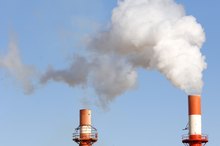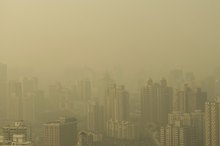How Do Factories Pollute the Air?
Industrial pollution is one of the primary sources of environmental contamination. According to the U.S. Environmental Protection Agency (EPA), air pollution levels rose 14 percent from 1990 to 2008 12. This trend reflects the amount of human-caused greenhouse gas emissions in the air. Air pollution can have profound effects on the health of the entire planet.
Sources
Factories pollute the air through fossil fuel emissions. These emissions include carbon dioxide, methane, and nitrous oxide. Combustion creates these toxic pollutants. While all of these are naturally-occurring substances, it is the high levels of emissions which are of concern. Industrial processes will also emit manmade emissions such as fluorine-containing gases such as hydrofluorocarbons.
- Factories pollute the air through fossil fuel emissions.
Ozone
The Human Impact On Air Pollution
Learn More
Chemical reactions create another air pollutant, ozone. Ozone forms with sunlight, nitrous oxide and volatile organic compounds in the air. Volatile organic compounds include fossil fuel emissions, chemical solvents, and byproducts of other industrial processes. When ozone stays close to the Earth's surface, it becomes harmful to human and environmental health. The Air Quality Index measures the levels of ozone and other common air pollutants.
- Chemical reactions create another air pollutant, ozone.
- Volatile organic compounds include fossil fuel emissions, chemical solvents, and byproducts of other industrial processes.
Acid Rain
The effects of air pollution are often widespread because pollutants can drift great distances from their source. Acid rain occurs when factory emissions combine with moisture present in the air to form acidic precipitation. Acid rain changes the pH of lakes, ponds, and soils to toxic levels. The U.S. Geological Survey reports that air pollution caused the pH of rainfall to drop to 4.2 in the Washington, D.C. area 3. Unpolluted rain has a pH of 5.6.
- The effects of air pollution are often widespread because pollutants can drift great distances from their source.
- The U.S. Geological Survey reports that air pollution caused the pH of rainfall to drop to 4.2 in the Washington, D.C. area 3.
Human Health Effects
Disadvantages of the Greenhouse Effect
Learn More
Air pollution has severe human health effects. Ozone, for example, causes irritation to the respiratory system. It can aggravate existing conditions such as asthma and bronchitis. Carbon monoxide can adversely affect your cardiovascular and central nervous systems. Your body has some natural resistance and will attempt to fight off the effects of pollutants. Yet, some damage may be irreversible, according to a report by the National Aeronautics Space Administration.
- Air pollution has severe human health effects.
- It can aggravate existing conditions such as asthma and bronchitis.
Climate Change
Air pollution caused by factories is one of the leading causes of climate change. The air is directly impacted, yet the effects go far beyond air quality issues. Greenhouse gas emissions can cause physical damage to plants and reduce crop yields 1. Plants store carbon dioxide in their tissues in a process called carbon sequestration. Carbon sequestration removes carbon dioxide from the atmosphere. By affecting plants, air pollution impairs one mechanism for improving air quality. This creates a vicious cycle of continued air quality impairment.
- Air pollution caused by factories is one of the leading causes of climate change.
- The air is directly impacted, yet the effects go far beyond air quality issues.
Related Articles
References
Resources
Writer Bio
Chris Dinesen Rogers has been online marketing for more than eight years. She has grown her own art business through SEO and social media and is a consultant specializing in SEO and website development. Her past work experience includes teaching pre-nursing students beginning biology, human anatomy and physiology. Rogers's more than 10 years in conservation makes her equally at home in the outdoors.









